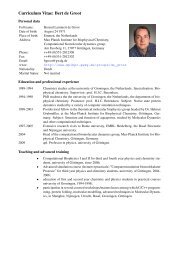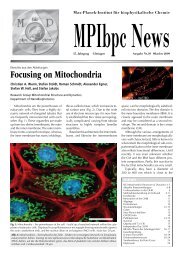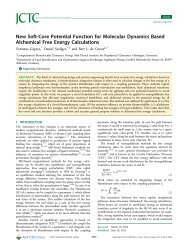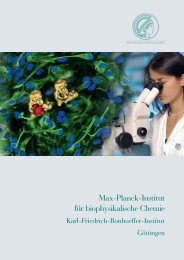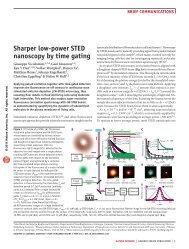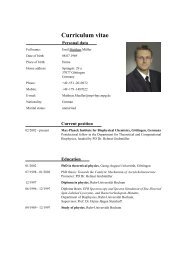Elastic Properties of Photoswitchable Azobenzene Polymers from ...
Elastic Properties of Photoswitchable Azobenzene Polymers from ...
Elastic Properties of Photoswitchable Azobenzene Polymers from ...
You also want an ePaper? Increase the reach of your titles
YUMPU automatically turns print PDFs into web optimized ePapers that Google loves.
Zuschriften<br />
adjacent azobenzene moiety is cis or trans (Figure 3).<br />
Figure 3b,c shows exemplarily the backbone dihedral angles<br />
Y <strong>of</strong> Lys7 in the all-cis and in the all-trans polymers,<br />
respectively, as a function <strong>of</strong> the applied force (black),<br />
together with the average Y angle and the statistical error<br />
(blue and red for cis and trans, respectively). In Figure 3d, the<br />
average backbone dihedral angle Y <strong>of</strong> all lysine residues is<br />
shown as a function <strong>of</strong> the applied force. For the all-cis<br />
polymer, the lysine residues already adopted the extended<br />
anti conformation at very low forces <strong>of</strong> between 0 and 300 pN<br />
(blue lines). These transitions also reveal themselves as steps<br />
in the force-extension trace <strong>of</strong> the all-cis model polymer (blue<br />
arrows in Figure 2).<br />
In the mixed polymer, Lys7, which is bonded directly to a<br />
cis azobenzene moiety (Figure 3a), also adopted the anti<br />
conformation very early (dash-dotted black line in Figure<br />
3d), in a similar manner to Lys4 in the all-cis polymer.<br />
In contrast, Lys4 and Lys10 with adjacent trans azobenzene<br />
units underwent syn-to-anti transitions only at rather large<br />
forces <strong>of</strong> between 600 and 800 pN (solid and dashed black<br />
lines, respectively). The same behavior was observed for all<br />
lysine amino acids in the all-trans polymer (red lines).<br />
In summary, our simulations showed that lysine residues<br />
bonded to trans azobenzene moieties tend to adopt the<br />
compact syn conformation (at up to 600–800 pN), whereas<br />
lysine residues adjacent to cis azo groups already undergo<br />
syn-to-anti conformational transitions at low to moderate<br />
forces below 300 pN. This preference for the extended anti<br />
conformation <strong>of</strong> lysine residues adjacent to cis azobenzene<br />
units explains the observed compensation effect. The difference<br />
in the length <strong>of</strong> the polymer chain because <strong>of</strong> cis–trans<br />
isomerization <strong>of</strong> the azobenzene units is reduced <strong>from</strong> 1.7 Š<br />
to 1.3–1.5 Š. However, in the AFM experiments, a value <strong>of</strong><br />
only 0.6 Š was measured. We conclude that in the AFM<br />
experiments only about 40% <strong>of</strong> the azobenzene moieties<br />
were effectively photoisomerized upon optical pumping. The<br />
major reason for the failure to attain the maximum value,<br />
which is about 70–80% as a result <strong>of</strong> the overlapping<br />
absorption bands <strong>of</strong> the trans and cis isomers, [35] in the AFM<br />
experiments is probably that only about half <strong>of</strong> the polymer<br />
was excited by the evanescent light field, in agreement with<br />
[22,23, 36]<br />
the estimate <strong>of</strong> the authors.<br />
The force-probe MD simulations also allow the investigation<br />
<strong>of</strong> the mechanics <strong>of</strong> the polymers at high forces and<br />
thus enable prediction <strong>of</strong> their elastic behavior even well<br />
beyond the force regime accessible to AFM. Only at forces<br />
larger than 1000 pN were mechanically induced cis-to-trans<br />
transitions <strong>of</strong> the azobenzene units observed in our simulations<br />
(data not shown). These isomerizations occurred by<br />
rotation about the central N=N bond, in agreement with<br />
recent ab initio calculations. [36] The high forces observed are<br />
consistent with the large thermal barrier to isomerization <strong>of</strong><br />
108 kJmol 1 , [37] which, as a result <strong>of</strong> the orthogonality <strong>of</strong> the<br />
rotation coordinate with respect to the pulling coordinate, is<br />
largely unaffected by the applied force. [36] Also in the AFM<br />
experiments no mechanical transitions were observed up to<br />
500 pN. [22, 23] At large forces <strong>of</strong> about 600–800 pN, the<br />
simulations also predict syn-to-anti transitions <strong>of</strong> the lysine<br />
residues in the all-trans polymer. For the short polymer used<br />
in this study, these transitions are visible as steps in the forceextension<br />
curve (red arrows in Figure 2a). For the much<br />
larger polymers used in the AFM experiments, these individual<br />
steps would not be resolved, but a tendency towards larger<br />
extensions would be observed in the force-extension traces <strong>of</strong><br />
the trans polymers at forces larger than about 600 pN.<br />
The dependence <strong>of</strong> the degree <strong>of</strong> extension <strong>of</strong> the lysine<br />
amino acids on the conformation <strong>of</strong> the azobenzene moiety<br />
they are bonded to demonstrates that the peptides interlinking<br />
the photoactive azobenzenes are not simply “passive<br />
glue”, but rather, through intermonomeric correlations,<br />
actively affect the elastic properties <strong>of</strong> the polymer. In the<br />
case at hand, the compensating effect <strong>of</strong> the lysine residues<br />
reduces the overall “optical” length contraction and thereby<br />
diminishes the work output <strong>of</strong> the polymer. We next investigated<br />
the possibility <strong>of</strong> using the structural and dynamical<br />
insight obtained <strong>from</strong> our studies to tailor and optimize<br />
photoswitchable polymers. For example, with the aim to<br />
increase the rigidity <strong>of</strong> the polymer backbone, we replaced the<br />
lysine and glycine residues with proline residues, so that less<br />
compensation and, accordingly, a larger work output could be<br />
expected.<br />
Figure 4 shows the elastic behavior <strong>of</strong> the all-cis, all-trans,<br />
and mixed (Pro-Azo-Pro) 4 dodecamers as determined <strong>from</strong> a<br />
set <strong>of</strong> force-probe MD simulations similar to those described<br />
above. The stiffer proline linkers indeed lead to an increased<br />
Figure 4. Force-probe MD force-extension curves obtained at a pulling<br />
velocity <strong>of</strong> 0.5 nmns 1 for the (Pro-Azo-Pro) 4 polymer. a) Curves <strong>of</strong> the<br />
whole all-cis (blue), all-trans (red), and mixed cis–trans–cis–trans polymers<br />
(black). Smooth lines describe the WLC fits. The extension<br />
difference between the cis and trans polymers is 1.70 Š/unit at 200 pN<br />
(dashed green line). b) Force-extension curves <strong>of</strong> individual azobenzene<br />
units and <strong>of</strong> proline residues (inset). The smooth lines represent<br />
20000-point averages.<br />
extension difference between the cis and trans polymers <strong>of</strong><br />
1.70 Š per azo unit (dashed green line), as compared to<br />
1.45 Š for the lysine-containing polymer (see Figure 2).<br />
Figure 4b shows the individual force-extension curves <strong>of</strong> the<br />
azobenzene and proline moieties in (Pro-Azo-Pro) 4. Apparently,<br />
and in contrast to (Lys-Azo-Gly) 4, the extension<br />
difference between the cis and trans azobenzene units is no<br />
longer compensated by the interlinking residues, which<br />
explains the increased Dl value <strong>of</strong> 1.70 Š. Accordingly, the<br />
work output is expected to be enhanced by about 15–20%<br />
relative to that <strong>of</strong> the lysine-containing polymer.<br />
Efficient and targeted optimization <strong>of</strong> photoswitchable<br />
polymers is a major challenge and requires detailed microscopic<br />
interpretation <strong>of</strong> the polymer mechanics. Herein, we<br />
4 www.angewandte.de 2007 Wiley-VCH Verlag GmbH & Co. KGaA, Weinheim Angew. Chem. 2007, 119, 1–7<br />
Ü<br />
Ü<br />
These are not the final page numbers!




